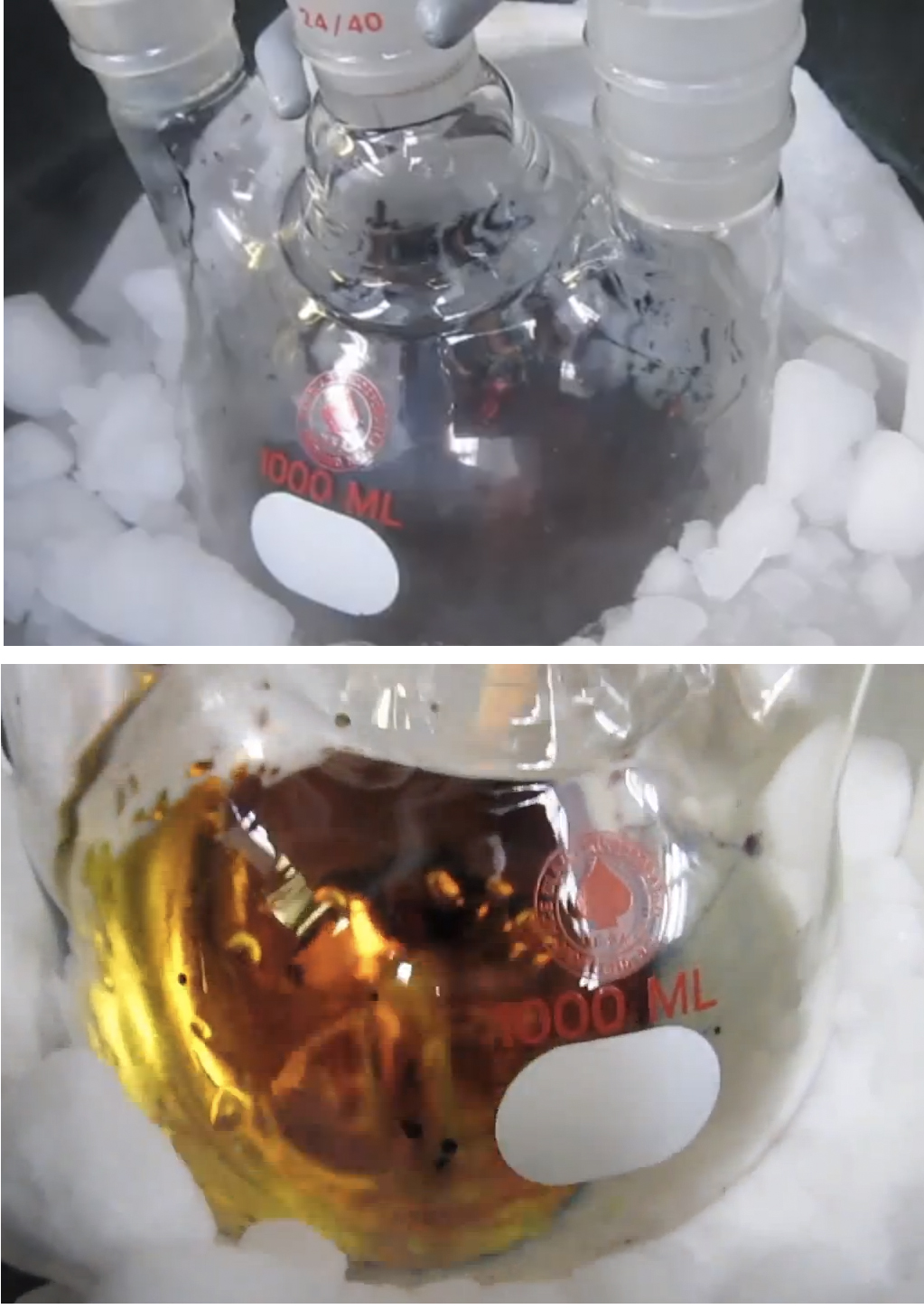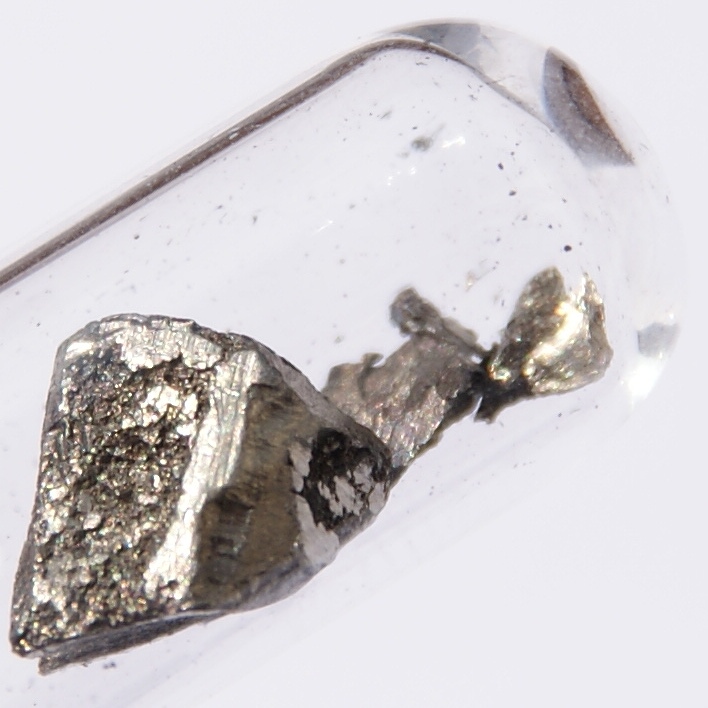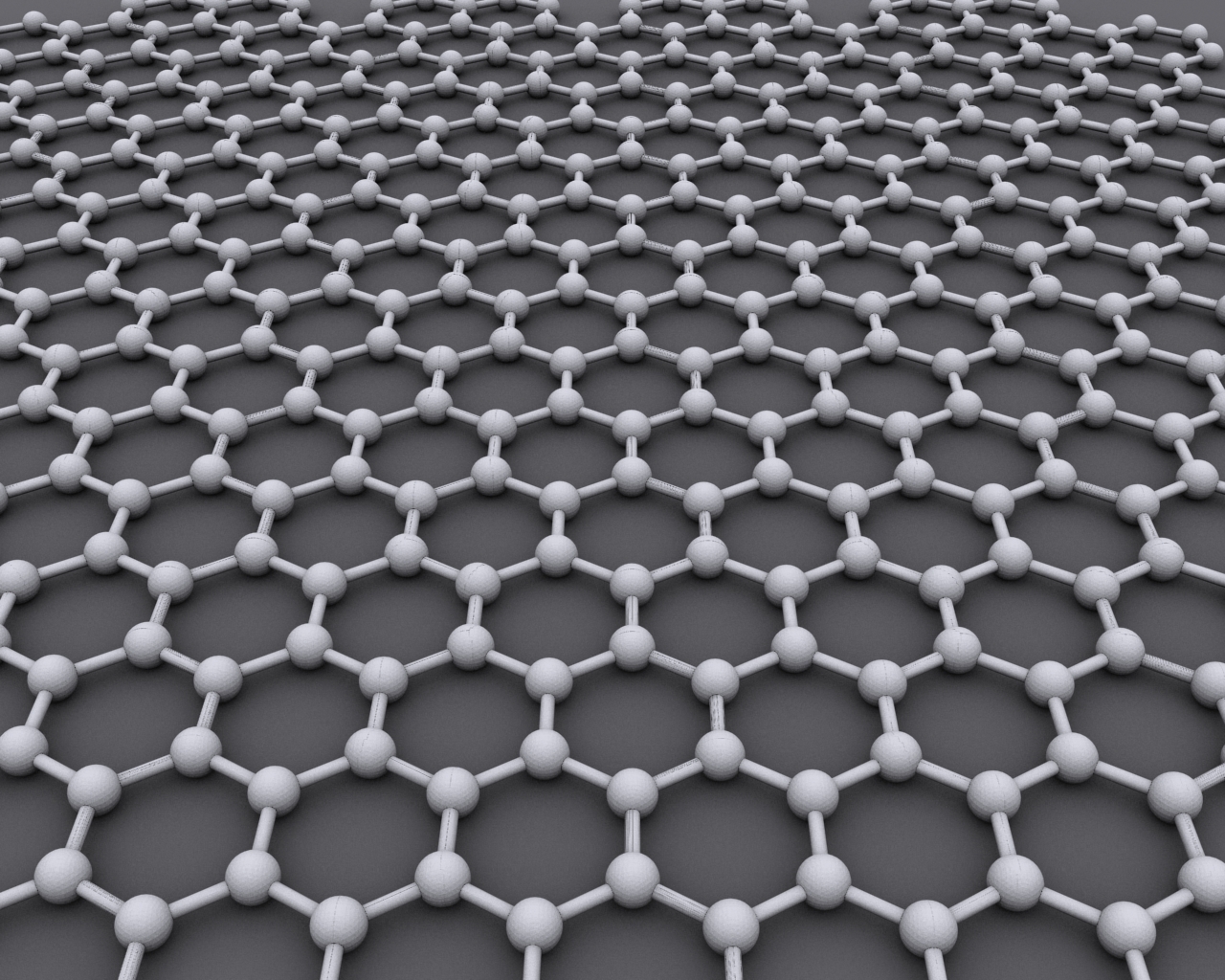|
Electride
An electride is an ionic compound in which an electron serves the role of the anion. Solutions Solutions of alkali metals in ammonia are electride salts. In the case of sodium, these blue solutions consist of a(NH3)6sup>+ and solvated electrons: :Na + 6 NH3 → a(NH3)6sup>+ + e− The cation a(NH3)6sup>+ is an octahedral coordination complex. Despite the name, the electron does not leave the sodium-ammonia complex, but it is transferred from Na to the vacant orbitals of the coordinated ammonia molecules. Similar solutions exist in hexamethylphosphoramide. Solid salts Many "inorganic electrides" have been described. Addition of a complexant like crown ether or .2.2cryptand to a solution of a(NH3)6sup>+e− affords a (crown ether)sup>+e− or a(2,2,2-crypt)sup>+e−. Evaporation of these solutions yields a blue-black paramagnetic solid with the formula a(2,2,2-crypt)sup>+e−. Most solid electride salts decompose above 240 K, although a24Al28O64sup>4 ... [...More Info...] [...Related Items...] OR: [Wikipedia] [Google] [Baidu] |
Electride 01
An electride is an ionic compound in which an electron serves the role of the anion. Solutions Solutions of alkali metals in ammonia are electride salts. In the case of sodium, these blue solutions consist of a(NH3)6sup>+ and solvated electrons: :Na + 6 NH3 → a(NH3)6sup>+ + e− The cation a(NH3)6sup>+ is an octahedral coordination complex. Despite the name, the electron does not leave the sodium-ammonia complex, but it is transferred from Na to the vacant orbitals of the coordinated ammonia molecules. Similar solutions exist in hexamethylphosphoramide. Solid salts Many "inorganic electrides" have been described. Addition of a complexant like crown ether or .2.2cryptand to a solution of a(NH3)6sup>+e− affords a (crown ether)sup>+e− or a(2,2,2-crypt)sup>+e−. Evaporation of these solutions yields a blue-black paramagnetic solid with the formula a(2,2,2-crypt)sup>+e−. Most solid electride salts decompose above 240 K, although a24Al28O64sup>4+(e� ... [...More Info...] [...Related Items...] OR: [Wikipedia] [Google] [Baidu] |
Solvated Electron
A solvated electron is a free electron in a solution, in which it behaves like an anion. An electron's being solvated in a solution means it is bound by the solution. The notation for a solvated electron in formulas of chemical reactions is "e−". Often, discussions of solvated electrons focus on their solutions in ammonia, which are stable for days, but solvated electrons also occur in water and many other solventsin fact, in any solvent that mediates outer-sphere electron transfer. Solvated electrons are responsible for a great deal of radiation chemistry. Salts containing solvated electrons are known as electrides. Ammonia solutions Liquid ammonia will dissolve all of the alkali metals and other electropositive metals such as Ca, Sr, Ba, Eu, and Yb (also Mg using an electrolytic process), giving characteristic blue solutions. For alkali metals in liquid ammonia, the solution is blue when dilute and copper-colored when more concentrated (> 3 molar). These solution ... [...More Info...] [...Related Items...] OR: [Wikipedia] [Google] [Baidu] |
Lanthanide
The lanthanide () or lanthanoid () series of chemical elements comprises at least the 14 metallic chemical elements with atomic numbers 57–70, from lanthanum through ytterbium. In the periodic table, they fill the 4f orbitals. Lutetium (element 71) is also sometimes considered a lanthanide, despite being a d-block element and a transition metal. The informal chemical symbol Ln is used in general discussions of lanthanide chemistry to refer to any lanthanide. All but one of the lanthanides are f-block elements, corresponding to the filling of the 4f electron shell. Lutetium is a d-block element (thus also a transition metal), and on this basis its inclusion has been questioned; however, like its congeners scandium and yttrium in group 3, it behaves similarly to the other 14. The term rare-earth element or rare-earth metal is often used to include the stable group 3 elements Sc, Y, and Lu in addition to the 4f elements. All lanthanide elements form trivalent cations, Ln3+, ... [...More Info...] [...Related Items...] OR: [Wikipedia] [Google] [Baidu] |
Disodium Helide
Disodium helide (Na2He) is a compound of helium and sodium that is stable at high pressures above . It was first predicted using the USPEX crystal structure prediction algorithm and then synthesised in 2016. Synthesis Na2He was predicted to be thermodynamically stable over 160 GPa and dynamically stable over 100 GPa. This means it should be possible to form at the higher pressure and then decompress to 100 GPa, but below that it would decompose. Compared with other binary compounds of other elements and helium, it was predicted to be stable at the lowest pressure of any such combination. This also means, for example, that a helium-potassium compound is predicted to require much higher pressures of the order of terapascals. The material was synthesized by putting tiny plates of sodium in a diamond anvil cell along with helium at 1600 bar and then compressing to 130 GPa and heating to 1,500 K with a laser. Disodium helide is predicted to be an insulator and ... [...More Info...] [...Related Items...] OR: [Wikipedia] [Google] [Baidu] |
Birch Reduction
The Birch reduction or Metal-Ammonia reduction is an organic reaction that is used to convert arenes to Cyclohexa-1,4-diene, 1,4-cyclohexadienes. The reaction is named after the Australian chemist Arthur Birch (organic chemist), Arthur Birch and involves the organic reduction of aromatic rings in an amine solvent (traditionally liquid ammonia) with an alkali metal (traditionally sodium) and a Hydron (chemistry), proton source (traditionally an Alcohol (chemistry), alcohol). Unlike catalytic hydrogenation, Birch reduction does not reduce the aromatic ring all the way to a cyclohexane. An example is the reduction of naphthalene in ammonia and ethanol: Reaction mechanism and regioselectivity A solution of sodium in liquid ammonia consists of the intensely blue electride salt [Na(NH3)x]+ e−. The solvated electrons add to the aromatic ring to give a radical ion, radical anion, which then abstracts a proton from the alcohol. The process then repeats at either the Arene substit ... [...More Info...] [...Related Items...] OR: [Wikipedia] [Google] [Baidu] |
Alkali Metal
The alkali metals consist of the chemical elements lithium (Li), sodium (Na), potassium (K),The symbols Na and K for sodium and potassium are derived from their Latin names, ''natrium'' and ''kalium''; these are still the origins of the names for the elements in some languages, such as German and Russian. rubidium (Rb), caesium (Cs), and francium (Fr). Together with hydrogen they constitute Group (periodic table)#Group names, group 1, which lies in the s-block of the periodic table. All alkali metals have their outermost electron in an s-orbital: this shared electron configuration results in their having very similar characteristic properties. Indeed, the alkali metals provide the best example of periodic trends, group trends in properties in the periodic table, with elements exhibiting well-characterised Homologous series, homologous behaviour. This family of elements is also known as the lithium family after its leading element. The alkali metals are all shiny, hardness, sof ... [...More Info...] [...Related Items...] OR: [Wikipedia] [Google] [Baidu] |
Sodium Amide
Sodium amide, commonly called sodamide (systematic name sodium azanide), is the inorganic compound with the formula . It is a salt composed of the sodium cation and the azanide anion. This solid, which is dangerously reactive toward water, is white, but commercial samples are typically gray due to the presence of small quantities of metallic iron from the manufacturing process. Such impurities do not usually affect the utility of the reagent. conducts electricity in the fused state, its conductance being similar to that of NaOH in a similar state. has been widely employed as a strong base in organic synthesis. Preparation and structure Sodium amide can be prepared by the reaction of sodium with ammonia gas, but it is usually prepared by the reaction in liquid ammonia using iron(III) nitrate as a catalyst. The reaction is fastest at the boiling point of the ammonia, c. −33 °C. An electride, , is formed as a reaction intermediate. : is a salt-like material and as su ... [...More Info...] [...Related Items...] OR: [Wikipedia] [Google] [Baidu] |
Anion
An ion () is an atom or molecule with a net electrical charge. The charge of an electron is considered to be negative by convention and this charge is equal and opposite to the charge of a proton, which is considered to be positive by convention. The net charge of an ion is not zero because its total number of electrons is unequal to its total number of protons. A cation is a positively charged ion with fewer electrons than protons (e.g. K+ ( potassium ion)) while an anion is a negatively charged ion with more electrons than protons (e.g. Cl− ( chloride ion) and OH− ( hydroxide ion)). Opposite electric charges are pulled towards one another by electrostatic force, so cations and anions attract each other and readily form ionic compounds. Ions consisting of only a single atom are termed ''monatomic ions'', ''atomic ions'' or ''simple ions'', while ions consisting of two or more atoms are termed polyatomic ions or ''molecular ions''. If only a + or − is present, it indi ... [...More Info...] [...Related Items...] OR: [Wikipedia] [Google] [Baidu] |
Salts
In chemistry, a salt or ionic compound is a chemical compound consisting of an assembly of positively charged ions ( cations) and negatively charged ions (anions), which results in a compound with no net electric charge (electrically neutral). The constituent ions are held together by electrostatic forces termed ionic bonds. The component ions in a salt can be either inorganic, such as chloride (Cl−), or organic, such as acetate (). Each ion can be either monatomic, such as sodium (Na+) and chloride (Cl−) in sodium chloride, or polyatomic, such as ammonium () and carbonate () ions in ammonium carbonate. Salts containing basic ions hydroxide (OH−) or oxide (O2−) are classified as bases, such as sodium hydroxide and potassium oxide. Individual ions within a salt usually have multiple near neighbours, so they are not considered to be part of molecules, but instead part of a continuous three-dimensional network. Salts usually form crystalline structures when solid. Sa ... [...More Info...] [...Related Items...] OR: [Wikipedia] [Google] [Baidu] |
F-center
An F-center or color center or Farbe center (from the original German ''Farbzentrum'', where ''Farbe'' means ''color'' and ''zentrum'' means ''center'') is a type of crystallographic defect in which an anionic Vacancy defect, vacancy in a crystal lattice is occupied by one or more unpaired electrons. Electrons in such a vacancy in a crystal lattice tend to absorb light in the visible spectrum such that a material that is usually Transparency (optics), transparent becomes colored. The greater the number of F centers, the more intense the color of the compound. F centers are a type of color center. This is used to identify many compounds, especially zinc oxide (yellow). History Before the discovery of point defects it was already known that some crystals can be discolored using various methods. In 1830 T.J. Pearsall discovered that fluorspar could be discolored using violet light. Thirty years later similar results were achieved by melting crystals together with a specific metal. In ... [...More Info...] [...Related Items...] OR: [Wikipedia] [Google] [Baidu] |
Single-layer Materials
In materials science, the term single-layer materials or 2D materials refers to crystalline solids consisting of a single layer of atoms. These materials are promising for some applications but remain the focus of research. Single-layer materials derived from single elements generally carry the -ene suffix in their names, e.g. graphene. Single-layer materials that are compounds of two or more elements have -ane or -ide suffixes. 2D materials can generally be categorized as either 2D allotropes of various elements or as compounds (consisting of two or more covalently bonding elements). It is predicted that there are hundreds of stable single-layer materials. The atomic structure and calculated basic properties of these and many other potentially synthesisable single-layer materials, can be found in computational databases. 2D materials can be produced using mainly two approaches: top-down exfoliation and bottom-up synthesis. The exfoliation methods include sonication, mechanical, h ... [...More Info...] [...Related Items...] OR: [Wikipedia] [Google] [Baidu] |
Dielectric Polarization
In electromagnetism, a dielectric (or dielectric medium) is an electrical insulator that can be polarised by an applied electric field. When a dielectric material is placed in an electric field, electric charges do not flow through the material as they do in an electrical conductor, because they have no loosely bound, or free, electrons that may drift through the material, but instead they shift, only slightly, from their average equilibrium positions, causing dielectric polarisation. Because of dielectric polarisation, positive charges are displaced in the direction of the field and negative charges shift in the direction opposite to the field. This creates an internal electric field that reduces the overall field within the dielectric itself. If a dielectric is composed of weakly bonded molecules, those molecules not only become polarised, but also reorient so that their symmetry axes align to the field. The study of dielectric properties concerns storage and dissipation of ... [...More Info...] [...Related Items...] OR: [Wikipedia] [Google] [Baidu] |





